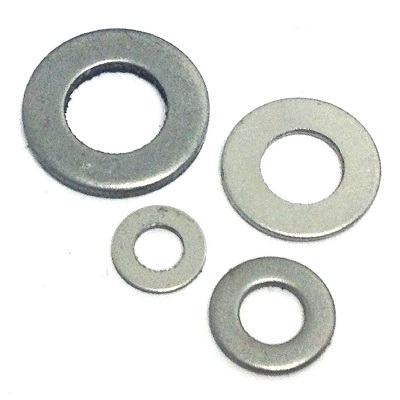Types of washers
Contents |
[edit] Introduction
A washer is a thin disc-shaped plate, typically with a hole through the centre, that is used in conjunction with a threaded fastener (such as a screw or bolt) to:
Washers are most commonly made from metal or plastic, although rubber and fibre versions are also available.
Although they can vary widely, in general, washers have an outer diameter that is approximately twice the inner diameter.
There are three main categories of washer:
[edit] Plain washers
Also known as a flat washer, this type of washer is a flat annulus or ring which is used to spread the load of a screwed fastening and prevent damage to the surface being fixed.
Types of plain washer include:
- Penny washer (or Fender washer): A flat washer with a larger outer diameter proportional to the central hole, meaning it can distribute loads more widely.
- Spherical washer: Consists of one radiused surface which, when used with a mating nut, allows for several degrees of misalignment between parts.
- C-washer: Can be slid in and out of position on a bolt or shaft.
- Countersunk washer: When secured, this type of washer creates a flush surface.
[edit] Spring washers
This type of washer has axial flexibility which helps prevent fastening or loosening as a result of vibrations or shock.
Types of spring washer include:
- Belleville washer: Has a slight conical shape which helps maintain tension in assemblies where there is thermal expansion and contraction.
- Curved disc spring: Is only curved in one direction and so is used to support relatively light loads with a wide deflection range.
- Wave washer: Has a ‘wave’ in the axial direction which makes it suitable for use as a cushion spring or spacer.
- Split washer: Has a ring that is split at one point and bent into a helical shape creating more friction and rotation resistance.
[edit] Locking washer
This type of washer is often interchangeable with spring washers and prevents fastening or loosening rotation.
Types of locking washer include:
- Helical spring: Increases the pre-load on the fastener while tightening. This provides protection against loosening.
- Toothed lock washer: Has serrations around its edge that can extend inward or outward to bite into the surface material and provide maximum torsional resistance.
- Tab washer: Has a side tab that can be bent into place against a nut, preventing rotation.
[edit] Related articles on Designing Buildings Wiki
Featured articles and news
RTPI leader to become new CIOB Chief Executive Officer
Dr Victoria Hills MRTPI, FICE to take over after Caroline Gumble’s departure.
Social and affordable housing, a long term plan for delivery
The “Delivering a Decade of Renewal for Social and Affordable Housing” strategy sets out future path.
A change to adoptive architecture
Effects of global weather warming on architectural detailing, material choice and human interaction.
The proposed publicly owned and backed subsidiary of Homes England, to facilitate new homes.
How big is the problem and what can we do to mitigate the effects?
Overheating guidance and tools for building designers
A number of cool guides to help with the heat.
The UK's Modern Industrial Strategy: A 10 year plan
Previous consultation criticism, current key elements and general support with some persisting reservations.
Building Safety Regulator reforms
New roles, new staff and a new fast track service pave the way for a single construction regulator.
Architectural Technologist CPDs and Communications
CIAT CPD… and how you can do it!
Cooling centres and cool spaces
Managing extreme heat in cities by directing the public to places for heat stress relief and water sources.
Winter gardens: A brief history and warm variations
Extending the season with glass in different forms and terms.
Restoring Great Yarmouth's Winter Gardens
Transforming one of the least sustainable constructions imaginable.
Construction Skills Mission Board launch sector drive
Newly formed government and industry collaboration set strategy for recruiting an additional 100,000 construction workers a year.
New Architects Code comes into effect in September 2025
ARB Architects Code of Conduct and Practice available with ongoing consultation regarding guidance.
Welsh Skills Body (Medr) launches ambitious plan
The new skills body brings together funding and regulation of tertiary education and research for the devolved nation.
Paul Gandy FCIOB announced as next CIOB President
Former Tilbury Douglas CEO takes helm.
UK Infrastructure: A 10 Year Strategy. In brief with reactions
With the National Infrastructure and Service Transformation Authority (NISTA).























